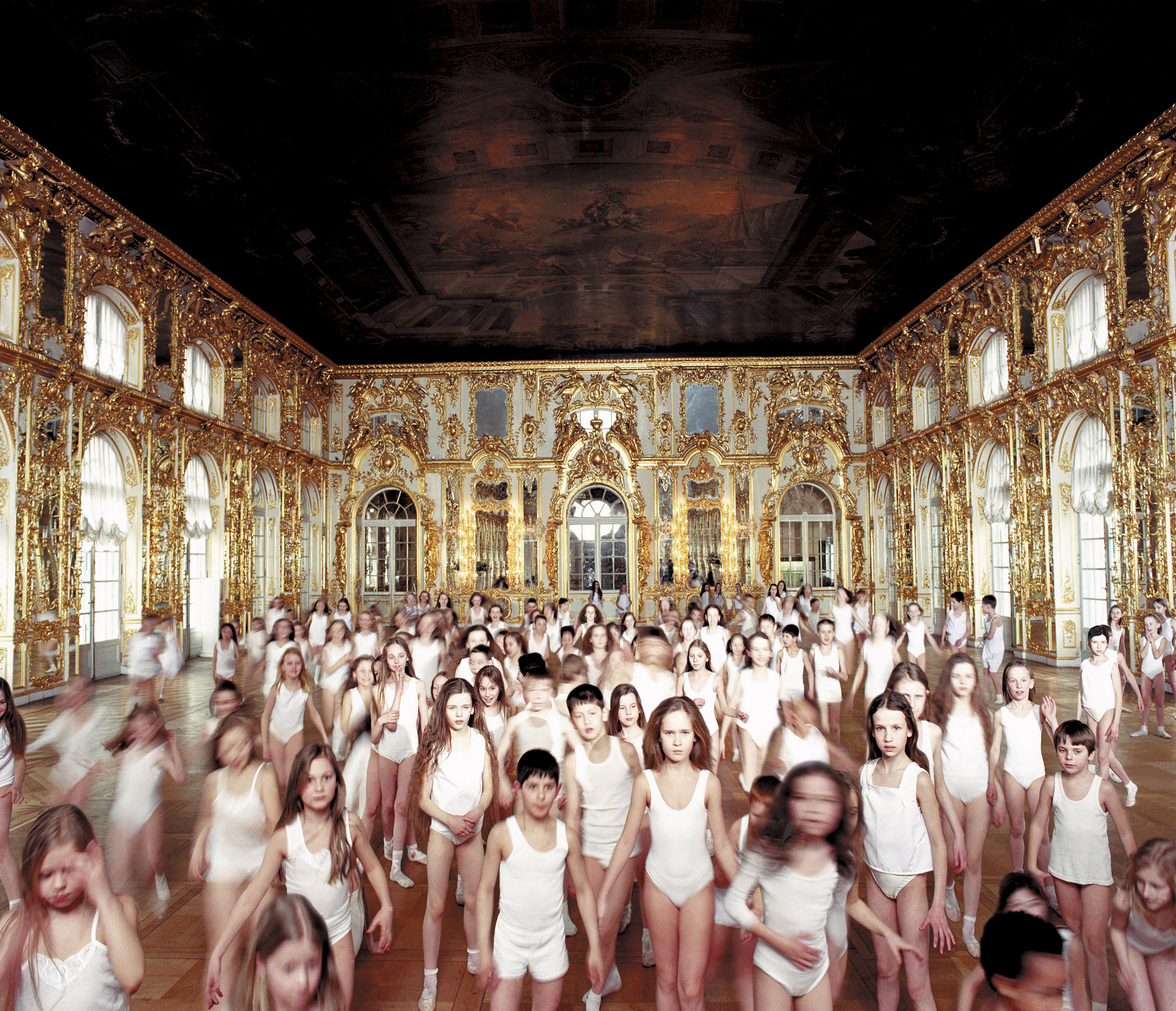(with Janita Craw) AES+F: King of the Forest (Maricaibo: Juan Ruiz Galeria, 2005).
Advertising agencies know they can always use beautiful wide-eyed children to pull on our heart strings and prize open our wallets. It’s the feel-good factor: fresh-faced kids sell the future, attaching their appeal to any product or ideology they’re aligned with. AES+F address this in their film trilogy King of the Forest (2001–3). Recalling the medieval folk tale of a King who imprisoned beautiful children in his palace for his pleasure, AES+F ‘steal’ hundreds of children, recruiting them from local model agencies, ballet schools, sports clubs … They dress them generically, in classic whites, sometimes suggesting sports kit and underwear. They install them in picturesque locations, film them in lingering slow-mo, then cut the footage to music. AES+F chose locations in the Old World, the New World, and the Third World. Le Roi Des Aulnes (2001) was shot in the gilded, mirrored halls of Tsarskoye Selo, Catherine the Great’s St. Petersburg palace. This film of beautiful children caught in a hall of mirrors suggests a mass audition or a ballet studio study after Degas. The kids instinctively court the camera, striking poses. More than Paradise (2002) was shot in Mohammed Ali, Cairo’s mosque-castle. AES+F required the children to demonstrate well-known ritual situations such as processions and circling, which have become cliches of the Islamic world in the Western media. For a complete contrast, KFNY (2003) was shot in the hubbub of New York’s Times Square, with Navy-recruiting ads playing on overhead video screens, displaying dramatic images of battleships, warplanes, and helicopters. Attentive to the ironies of the new world order, this final installment involves a deep contradiction. Its all-embracing multi-cultural cast of ‘heroes’—its ‘rainbow coalition’—lining up on the side of America.
King of the Forest drips with art, advertising, and pop-culture associations. AES+F put a real spin on Vanessa Beecroft (with her performance-tableaux of inscrutable glamorous naked women), Shirin Neshat (with her orientalist videos of massed milling ‘others’), and Art Club 2000 (a tribe of identically dressed juveniles who gathered in Times Square to be photographed). It also recalls fashion advertising campaigns for Benetton (whose multicultural appeal veils dubious third world labour practices), Calvin Klein and others. The King of the Forest trilogy remains ambiguous. The films are like ads which largely forgot to mention their product. The children instead seem to absorb the background ideological associations of their locations. The films’ extended durations grant us the chance to map a variety of contradictory interpretations and affects: to see the children as innocent and knowing; as vulnerable and sublime; as the filmmakers’ patsies and as coquettish spoilt agents. One moment we are jealous of their perfect existence and good looks, the next fearful for their safety. Equally our concern over their possible exploitation gives way to a realisation that their beauty can be used to exploit us. Kids may be captive but they are also captivating, their beauty exercising a magical force over us. As Elena Zaitseva explains, AES+F leave us ‘balanced on a fine line between nobleness and treachery, bewitched by a beauty that has turned into a trap.’ ‘Our protest against the “stealing” of children does not prevent us from admiring them.’
Sometimes reality intervenes after the fact, changing the significance of an artwork forever. It’s hard not to read King of the Forest in this way. On 1 September 2004, terrorists calling for Chechnyan independence ‘stole’ hundreds of staff and students at a school in the Russian town of Beslan. They herded their hostages into the school’s gym. Deprived of food and water, the hostages were forced to drink their own urine. To cope with the stifling heat they were stripped to their underwear. On several occasions, released or escaped children were photographed fleeing in their smalls. By targeting ‘innocent children’, the terrorists were guaranteed the glare of world attention. The media milked it for all it was worth, giving the terrorists the publicity they sought, viewers something racy, and their advertisers a bigger audience. Three days in, a shoot-out between the terrorists and Russian security forces claimed the lives of over 300 hostages, more than 170 of them children. Despite moralising over evil, the media would be criticised for participating in it by running exploitative suggestive images of traumatised children in their whites. It is at such moments that our moral panic over child abuse spectacularly aligns with reality, and our obsession with safeguarding childhood innocence reveals its pornographic underbelly.
